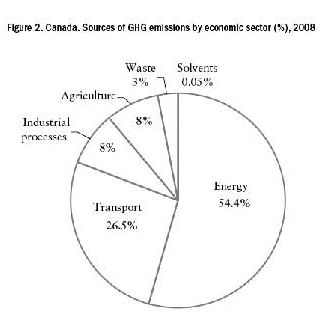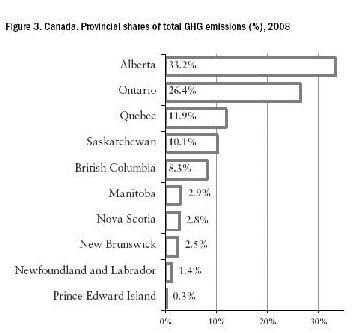 Also discussed here: Kyoto Protocol (Wikipedia)
Also discussed here: Kyoto Protocol (Wikipedia)And here: State-and-Trends of the Environment: 1987–2007 Chapter 2 Atmosphere (44 page pdf, United National Environment Program, 2008)
And here: History of the Global Climate Change Regime (18 page pdf, Daniel Bodansky, 2012)
And here: 2014 Air Quality and Climate Change Management Plan (165 page pdf, City of Ottawa Environment Committee, May 20, 2014)
The quick answer to the question posed is: lack of engagement and consensus for action by the provinces who have prime responsibility for energy, environment and natural resources. Today, we review an academic report and analysis of the reasons for Canada’s failure to meet international agreements to reduce greenhouse gas emissions since the first commitments were made by the Prime Minister at the United Nations-sponsored “Changing the Atmosphere Conference” in Toronto in 1988 - where it was agreed that Global CO2 emissions be cut by 20% by 2005 but without national obligations which came later with the 1997 Kyoto Protocol. He made this commitment without having prior provincial support to do so – an issue not a faced by most other heads of government, even from nations with states or provinces, such as Australia or Germany (whose efforts to reduce GHG emissions are also analysed in this report).
The lack of national leadership (and mandate), the lack of provincial consensus and the difficulty in getting provincial agreement, even with a national coordination secretariat (which existed from 1998-2003), is blamed on the uneven costs for implementing such a plan, with most of the costs and emissions coming from Alberta and Ontario whose energy and transportation sectors make up over 80% of the emissions for Canada. On top of this, the resistance of Canada’s largest trading partner, the USA, to agree to reductions has hampered Canadian efforts, let alone ratify the agreement under the Kyoto Protocol to reduce emissions by 6% (base year 1990) by 2012. The current administration in 2011 decided to withdraw from the Kyoto Protocol and adopt a goal of a 17% reduction in total emissions (from a 2005 base year) by 2020, consistent with American plans, but again without consensus on provincial responsibilities.

Key Quotes:
“By 2020, existing federal and provincial programs will only achieve half of Canada’s goal of reducing greenhouse gas (GHG) emissions to 17% below the 2005 level.”
“if all provinces fully meet their targets… and without including reductions resulting from federal government policy, total Canadian emissions in 2020 would be 598.7 Mt. That would be a reduction of 246.5 Mt from projected Business as Usual level of emissions in 2020"
“The Canadian Constitution gives ownership of natural resources to the provinces, which means they have guaranteed jurisdiction in the policy fields of environment and energy; and the larger provinces such as British Columbia, Alberta, Ontario, and Quebec have consistently resisted federal government intrusion into what they see as their environmental policy jurisdiction”
“Canada is in the process of implementing not just one climate-change plan; instead, it has eleven plans,.. being implemented separately and almost completely without coordination by eleven governments—the federal government and ten provincial governments. … a “fragmented ‘go-it-alone’ approach.”
“The main thing which must be co-ordinated is the allocation of the total GHG reduction amongst the various sources, such as transportation, resource extraction, building insulation, and manufacturing. Since their reduction costs vary, economic efficiency means we cannot ask each source to reduce by the same percentage amount.”
“Both Australia and Germany are relatively centralized federated states, meaning that, unlike Canada, in those countries national climate-change policy can be made by the national government alone, without explicit agreement among subnational governments on cost allocation.”
“In Canada, Alberta and Saskatchewan, presumably due to the fact they have faced higher per-capita reduction costs than other provinces have, not surprisingly, been the provinces most resistant to national policy”
"Due to immigration, the Canadian population increased steadily from 1990 to 2011, with a 24.63% net increase over that time” [an increase of about 1% per year]







No comments:
Post a Comment